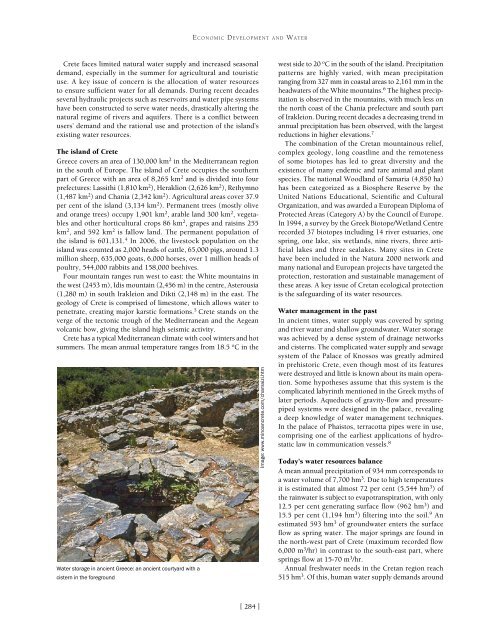222893e
222893e
222893e
Create successful ePaper yourself
Turn your PDF publications into a flip-book with our unique Google optimized e-Paper software.
ECONOMIC DEVELOPMENT AND WATERCrete faces limited natural water supply and increased seasonaldemand, especially in the summer for agricultural and touristicuse. A key issue of concern is the allocation of water resourcesto ensure sufficient water for all demands. During recent decadesseveral hydraulic projects such as reservoirs and water pipe systemshave been constructed to serve water needs, drastically altering thenatural regime of rivers and aquifers. There is a conflict betweenusers’ demand and the rational use and protection of the island’sexisting water resources.The island of CreteGreece covers an area of 130,000 km 2 in the Mediterranean regionin the south of Europe. The island of Crete occupies the southernpart of Greece with an area of 8,265 km 2 and is divided into fourprefectures: Lassithi (1,810 km 2 ), Heraklion (2,626 km 2 ), Rethymno(1,487 km 2 ) and Chania (2,342 km 2 ). Agricultural areas cover 37.9per cent of the island (3,134 km 2 ). Permanent trees (mostly oliveand orange trees) occupy 1,901 km 2 , arable land 300 km 2 , vegetablesand other horticultural crops 86 km 2 , grapes and raisins 255km 2 , and 592 km 2 is fallow land. The permanent population ofthe island is 601,131. 4 In 2006, the livestock population on theisland was counted as 2,000 heads of cattle, 65,000 pigs, around 1.3million sheep, 635,000 goats, 6,000 horses, over 1 million heads ofpoultry, 544,000 rabbits and 158,000 beehives.Four mountain ranges run west to east: the White mountains inthe west (2453 m), Idis mountain (2,456 m) in the centre, Asterousia(1,280 m) in south Irakleion and Dikti (2,148 m) in the east. Thegeology of Crete is comprised of limestone, which allows water topenetrate, creating major karstic formations. 5 Crete stands on theverge of the tectonic trough of the Mediterranean and the Aegeanvolcanic bow, giving the island high seismic activity.Crete has a typical Mediterranean climate with cool winters and hotsummers. The mean annual temperature ranges from 18.5 o C in theWater storage in ancient Greece: an ancient courtyard with acistern in the foregroundImage: www.minoancrete.com/chamaizi.htmwest side to 20 o C in the south of the island. Precipitationpatterns are highly varied, with mean precipitationranging from 327 mm in coastal areas to 2,161 mm in theheadwaters of the White mountains. 6 The highest precipitationis observed in the mountains, with much less onthe north coast of the Chania prefecture and south partof Irakleion. During recent decades a decreasing trend inannual precipitation has been observed, with the largestreductions in higher elevations. 7The combination of the Cretan mountainous relief,complex geology, long coastline and the remotenessof some biotopes has led to great diversity and theexistence of many endemic and rare animal and plantspecies. The national Woodland of Samaria (4,850 ha)has been categorized as a Biosphere Reserve by theUnited Nations Educational, Scientific and CulturalOrganization, and was awarded a European Diploma ofProtected Areas (Category A) by the Council of Europe.In 1994, a survey by the Greek Biotope/Wetland Centrerecorded 37 biotopes including 14 river estuaries, onespring, one lake, six wetlands, nine rivers, three artificiallakes and three sealakes. Many sites in Cretehave been included in the Natura 2000 network andmany national and European projects have targeted theprotection, restoration and sustainable management ofthese areas. A key issue of Cretan ecological protectionis the safeguarding of its water resources.Water management in the pastIn ancient times, water supply was covered by springand river water and shallow groundwater. Water storagewas achieved by a dense system of drainage networksand cisterns. The complicated water supply and sewagesystem of the Palace of Knossos was greatly admiredin prehistoric Crete, even though most of its featureswere destroyed and little is known about its main operation.Some hypotheses assume that this system is thecomplicated labyrinth mentioned in the Greek myths oflater periods. Aqueducts of gravity-flow and pressurepipedsystems were designed in the palace, revealinga deep knowledge of water management techniques.In the palace of Phaistos, terracotta pipes were in use,comprising one of the earliest applications of hydrostaticlaw in communication vessels. 8Today’s water resources balanceA mean annual precipitation of 934 mm corresponds toa water volume of 7,700 hm 3 . Due to high temperaturesit is estimated that almost 72 per cent (5,544 hm 3 ) ofthe rainwater is subject to evapotranspiration, with only12.5 per cent generating surface flow (962 hm 3 ) and15.5 per cent (1,194 hm 3 ) filtering into the soil. 9 Anestimated 593 hm 3 of groundwater enters the surfaceflow as spring water. The major springs are found inthe north-west part of Crete (maximum recorded flow6,000 m 3 /hr) in contrast to the south-east part, wheresprings flow at 15-70 m 3 /hr.Annual freshwater needs in the Cretan region reach515 hm 3 . Of this, human water supply demands around[ 284 ]


